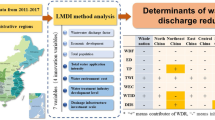Abstract
In this study, reduction in sulfur dioxide (SO2) emission is decomposed into three parts: source prevention, process control and end-of-pipe treatment, using the Logarithmic Mean Divisia Index method (LMDI). Source prevention and process control are defined as processintegrated treatment. It is found that from 2001 to 2010 the reduction of SO2 emission density in China was mainly contributed by end-of-pipe treatment. From the 10th Five Year Plan (FYP) period (2001–2005) to the 11th FYP period (2006–2010), the Chinese government has attempted to enhance process-integrated treatment. However, given its initial effort, the effect is limited compared with that of the end-of-pipe treatment. The effectiveness of environmental regulation and technology in the reduction of SO2 density in 30 provinces (municipality/autonomous regions) from 2001 to 2010 is also investigated. This implies that environmental regulation and technology promote process control and end-of-pipe treatment significantly, but does not influence source prevention. Furthermore, environmental technology will only take effect under the circumstances of stringent environmental regulation. Therefore, to fulfill the whole process treatment, environmental regulation should be strengthened and environmental technology upgraded at the same time.
Similar content being viewed by others
References
Zotter K A. “End-of-pipe” versus “process-integrated” water conservation solutions — a comparison of planning, implementation and operating phases. Journal of Cleaner Production, 2004, 12(7): 685–695
Hitchens D, Trainor M, Clausen J, Thankappan S B, de Marchi B. Small and Medium Sized Companies in Europe: Environmental Performance, Competitiveness and Management: International EU Case Studies. Heidelberg: Springer Verlag, 2003
Frondel M, Horbach J, Rennings K. End-of-pipe or cleaner production? An empirical comparison of environmental innovation decisions across OECD countries. Business Strategy and the Environment, 2007, 16(8): 571–584
Rennings K, Ziegler A, Zwick T. Employment changes in environmentally innovative firms. ZEW Working Paper, No.01-46, 2001. Available online at http://scholar.google.com/scholar?q=Employment+changes+in+environmentally+innovative+firms&btnG=&hl=zh-CN&as_sdt=0%2C5 (accessed May 30 2013).
Rennings K, Kemp R, Bartolomeo M, Hemmelskamp J, Hitchens D. Blueprints for an integration of science, technology and environmental policy (BLUEPRINT). Zentrum für Europäische Witschaftsführung (ZEW), 2003. Available online at http://scholar.google.com.hk/scholar?q=Blueprints+for+an+integration+of+science,+technology+and+environmental+policy&hl=zh-CN&as_sdt=0&as_vis=1&oi=scholart&sa=X&ei=rXSoUc2HNo3pkgX7roDIDA&ved=0CCgQgQMwAA (accessed May 30, 2013)
Zhou S X. Exploring a new road for environmental protection in China, and building a strong technology support system. Environment and Ecology, 2011, 8(3): 515 (in Chinese)
Jaffe A B, Newell R G, Stavins R N. Environmental policy and technological change. Environmental and Resource Economics, 2002, 22(1–2): 41–70
Brunnermeier S B, Cohen M A. Determinants of environmental innovation in US manufacturing industries. Journal of Environmental Economics and Management, 2003, 45(2): 278–293
Anderson S T, Newell R G. Information programs for technology adoption: the case of energy-efficiency audits. Resource and Energy Economics, 2004, 26(1): 27–50
Kerr S, Newell R G. Policy-induced technology adoption: evidence from the US lead phase down. Journal of Industrial Economics, 2003, 51(3): 317–343
Lee S Y, Rhee S K. From end-of-pipe technology towards pollution preventive approach: the evolution of corporate environmentalism in Korea. Journal of Cleaner Production, 2005, 13(4): 387–395
Hammar H, Löfgren A. Explaining adoption of end of pipe solutions and clean technologies — determinants of firms’ investments for reducing emissions to air in four sectors in Sweden. Energy Policy, 2010, 38(7): 3644–3651
Pavitt K. Sectoral patterns of technical change: towards a taxonomy and a theory. Research Policy, 1984, 13(6): 343–373
Sun X, Lei H Y. Empirical research on the effect of whole process pollution reduction in China — take the provincial SO2 reduction as an example. East China Economic Management, 2012, 26(7): 58–61 (in Chinese)
Ang B W, Choi K H. Decomposition of aggregate energy and gas emission intensities for industry: a refined Divisia Index method. Energy, 1997, 18(3): 59–73
Howarth R B, Schipper L, Duerr P A, Strøm S. Manufacturing energy use in eight OECD countries. Energy Economics, 1991, 13 (2): 135–142
Park S H. Decomposition of industrial energy consumption: an alternative method. Energy Economics, 1992, 14(4): 265–270
Boyd G A, Hanson D A, Sterner T. Decomposition of changes in energy intensity:a comparison of the Divisia Index and other methods. Energy Economics, 1988, 10(4): 309–312
Yu F, Qi J G. Decomposing and analyzing the environmental pollution under the opening economic circumstances. Statistical Research, 2007, 24(1): 47–53 (in Chinese)
Lin Q H, Chen G Y, Du W C, Niu H P. Spillover effect of environmental investment: evidence from panel data at provincial level in China. Frontiers of Environmental Science & Engineering, 2012, 6(3): 412–420
Author information
Authors and Affiliations
Corresponding author
Rights and permissions
About this article
Cite this article
Zhang, P. End-of-pipe or process-integrated: evidence from LMDI decomposition of China’s SO2 emission density reduction. Front. Environ. Sci. Eng. 7, 867–874 (2013). https://doi.org/10.1007/s11783-013-0541-0
Received:
Accepted:
Published:
Issue Date:
DOI: https://doi.org/10.1007/s11783-013-0541-0




